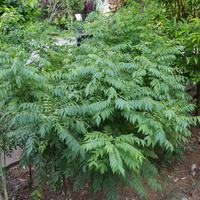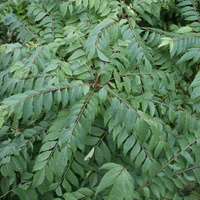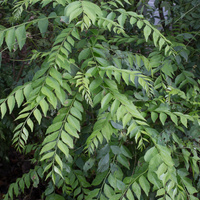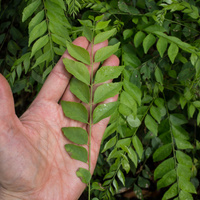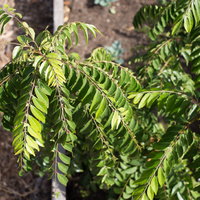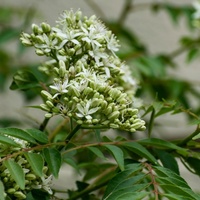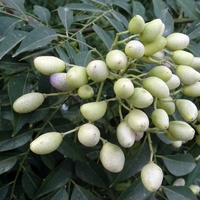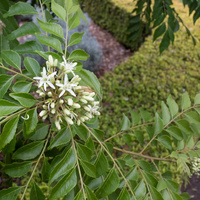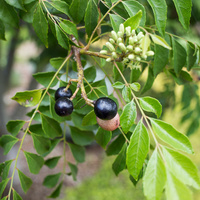Common name: Curry Leaf
Other common names: Curry Bush, Indian Bay
Description
Originating in eastern India and Sri Lanka, this shrub or small tree is cultivated for its leaves, which are utilised as a spice. Nowadays, it is grown worldwide, especially where Indians and Sri Lankans have migrated and settled, including countries in Asia, Africa, the West Indies and the South Pacific.
It is a fast-growing shrub or small evergreen tree that may reach a height of up to 6 m (20 ft), though it is typically 2 to 3 m (6.6 to 9.8 ft) tall with long, wispy, wide-spreading branches. The bark is brown or dark green, dotted with raised wart-like pores and thin, being easily peeled off in long strips, exposing white underbark.
Leaves are large, up to 30 cm (1 ft) long and feathery, consisting of up to twenty-four leaflets arranged in pairs along the length. The individual leaflets are dull green, oval with a pointed tip, slightly wavy on the margins, and with short leaf stalks. They give off a strong curry-like aroma when crushed.
Flowers are small, white with five fused petals forming a funnel shape and bi-sexual, having male and female parts. They bloom mainly in spring but also on and off throughout the year, in large, open clusters at the ends of the branches and give off a sweet scent, attracting honeybees and hummingbirds.
The fertilised flowers develop into a round to oval fruit resembling a small grape. Green when young, they turn dark purple to almost black when ripe, usually in summer, and when squeezed, release blue-coloured pulp with one to two largish green seed inside.
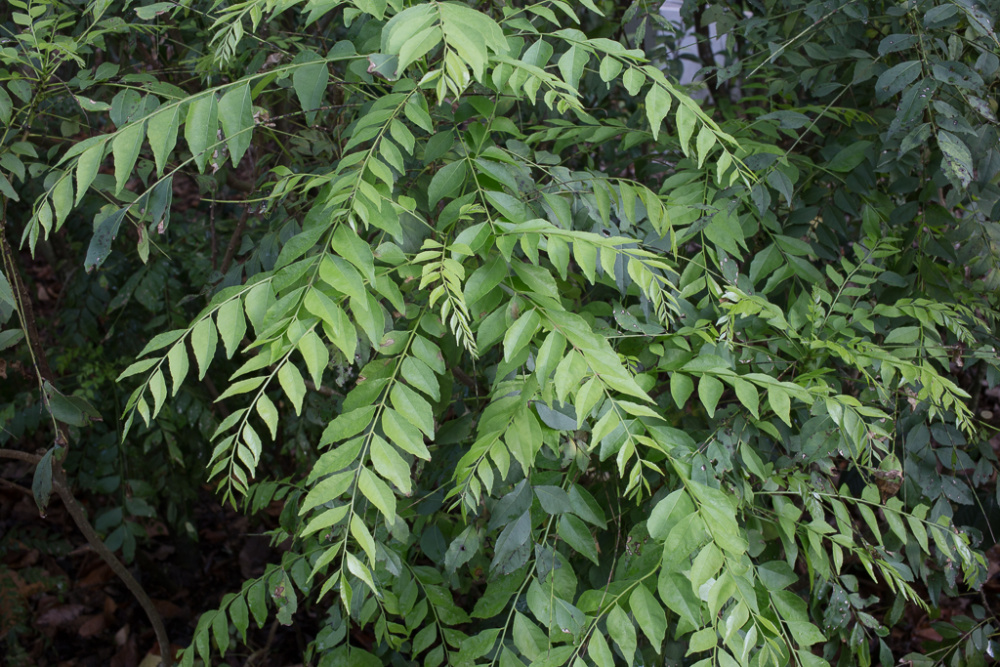
Use
The leaves are a popular spice in south Indian and Sri Lankan cooking. They are commonly fried whole in oil, usually with other spices and curry paste or powder when preparing curry dishes. Although not actually an ingredient in curry pastes or powders, their distinctive curry aroma has led to the name 'Curry leaf' being applied to the plant and leaves in English-speaking countries.
The mature leaves are picked and used fresh or are stored dried or chilled in the refrigerator or freezer. However, they are at their most flavoursome when fresh, as they tend to lose their flavour with time. Some people are put off by their strong aroma, which becomes more agreeable when cooked.
Health use
In India, the leaves are thought to aid appetite and digestion. They are also crushed to apply as a poultice to treat burns and other skin ailments and to the scalp as a hair tonic.
Climate
Grows naturally in humid subtropical and tropical climates, generally frost-free areas with annual lows of 10 to 25°C, annual highs of 20 to 35°C, annual rainfall of 700 to 3000 mm and a dry season of 8 months or less.
Plants can also be grown in pots or containers in cooler climates, if these can be moved indoors when temperatures fall below 5°C (41°F).
Growing
New plants can be grown from seed, cuttings or root suckers. Germination is slow, taking three weeks or longer, and soaking the seed in warm water for twenty-four hours helps speed up the process.
It performs best on rich, well-drained loam or sand soils of a moderately acid to neutral nature, generally with a pH of 5.5 to 7.0 and on sites with full to partial sun exposure. It has poor tolerance to slow-draining or waterlogged soils. It is susceptible to iron deficiency in alkaline or limestone soils.
Problem features
Birds eat the fruit and disperse the seed. It is recorded as having naturalised in tropical Australia, classed as a weed of the natural environment. It is also known to sucker profusely from the roots.
Where it grows
References
Books
-
Attokaran, M. 2011, Natural food flavors and colorants, Institute of Food Technologists, Wiley-Blackwell Publishing, Oxfordshire
-
Chevallier, A. 2000, Encyclopedia of herbal medicine, 2nd American ed., Dorling Kindersley, New York
-
Krishen, P. 2006, Trees of Delhi : a field guide, Dorling Kindersley Publishers, Delhi
-
Martin, F. W & Ruberte, R. M. 1975, Edible leaves of the tropics, U.S. Agency for International Development (USAID), and the Agricultural Research Service, U.S. Department of Agriculture (USDA), Mayaguez, Puerto Rico
-
Norrington, L. & Campbell, C. 2001, Tropical food gardens : a guide to growing fruit, herbs and vegetables in tropical and sub-tropical climates, Bloomings Books, Hawthorn, Victoria
-
Parrotta, J. A. 2001, Healing plants of peninsular India, CABI Publishing, Wallingford, Oxfordshire
-
Randall, R. P. 2002, A global compendium of weeds, R.G. and F.J. Richardson Press, Melbourne
-
Randall, R. P. 2007, The introduced flora of Australia and its weed status, Cooperative Research Centre for Australian Weed Management, Glen Osmond, South Australia
-
Seidemann, J. 2005, World spice plants: economic usage botany taxonomy, Springer-Verlag, Berlin
-
Selvam, V. 2007, Trees and shrubs of the Maldives, Food and Agriculture Organisation (FAO) RAP publication (Maldives), Thammada Press Company Ltd., Bangkok
-
Staples, G. & Kristiansen, M. S. 1999, Ethnic culinary herbs : a guide to identification and cultivation in Hawaii, University of Hawaii Press, Honolulu
-
Troup, R.S. & Joshi, H. B. 1975 to 1981, Silviculture of Indian Trees (3 volumes), Government of India Publications, New Delhi
Articles, Journals, Reports and Working Papers
-
Morton, J. F. 1976, Pestiferous spread of many ornamental and fruit species in south Florida. In Proceedings of the Florida State Horticultural Society (Vol. 89, pp. 348-353).
